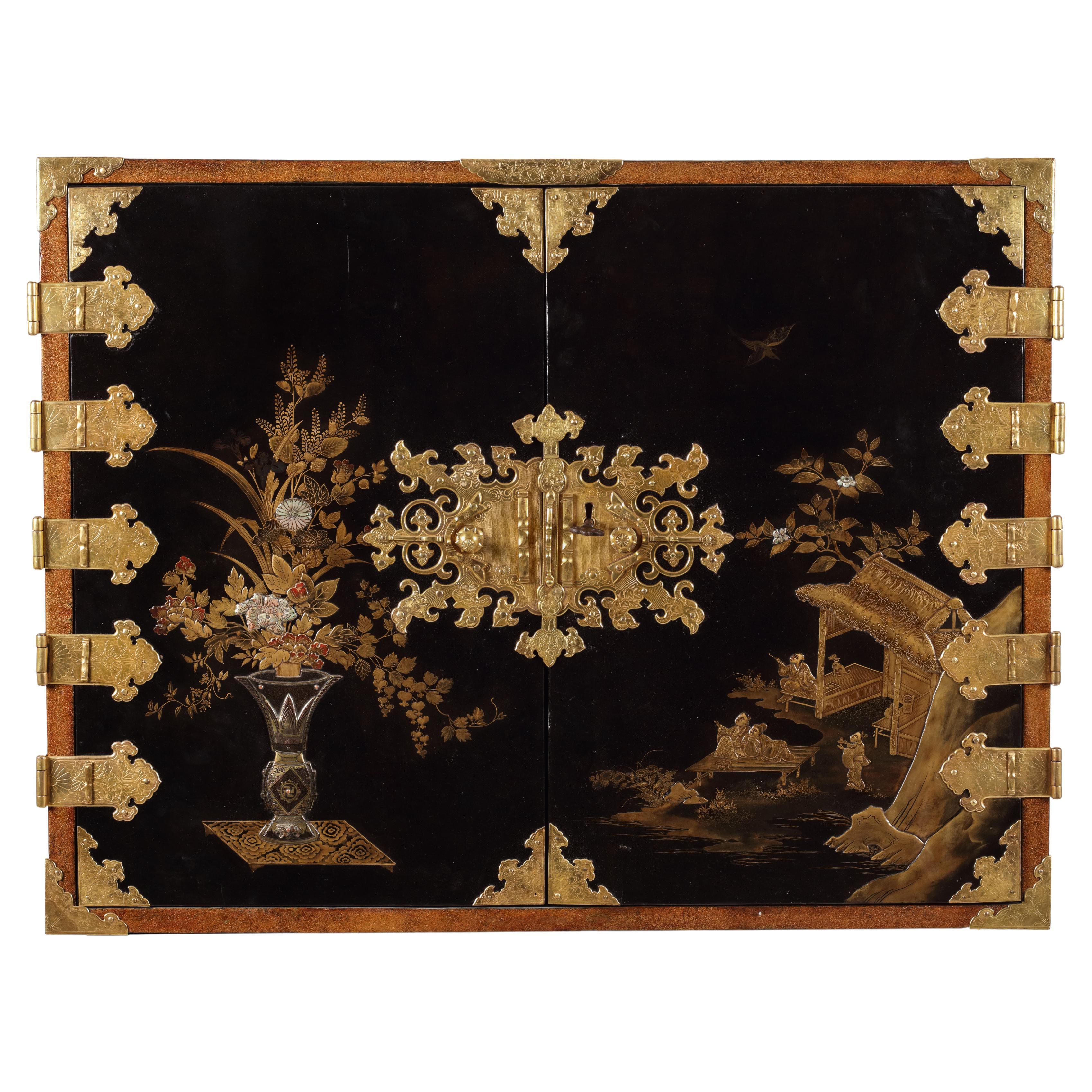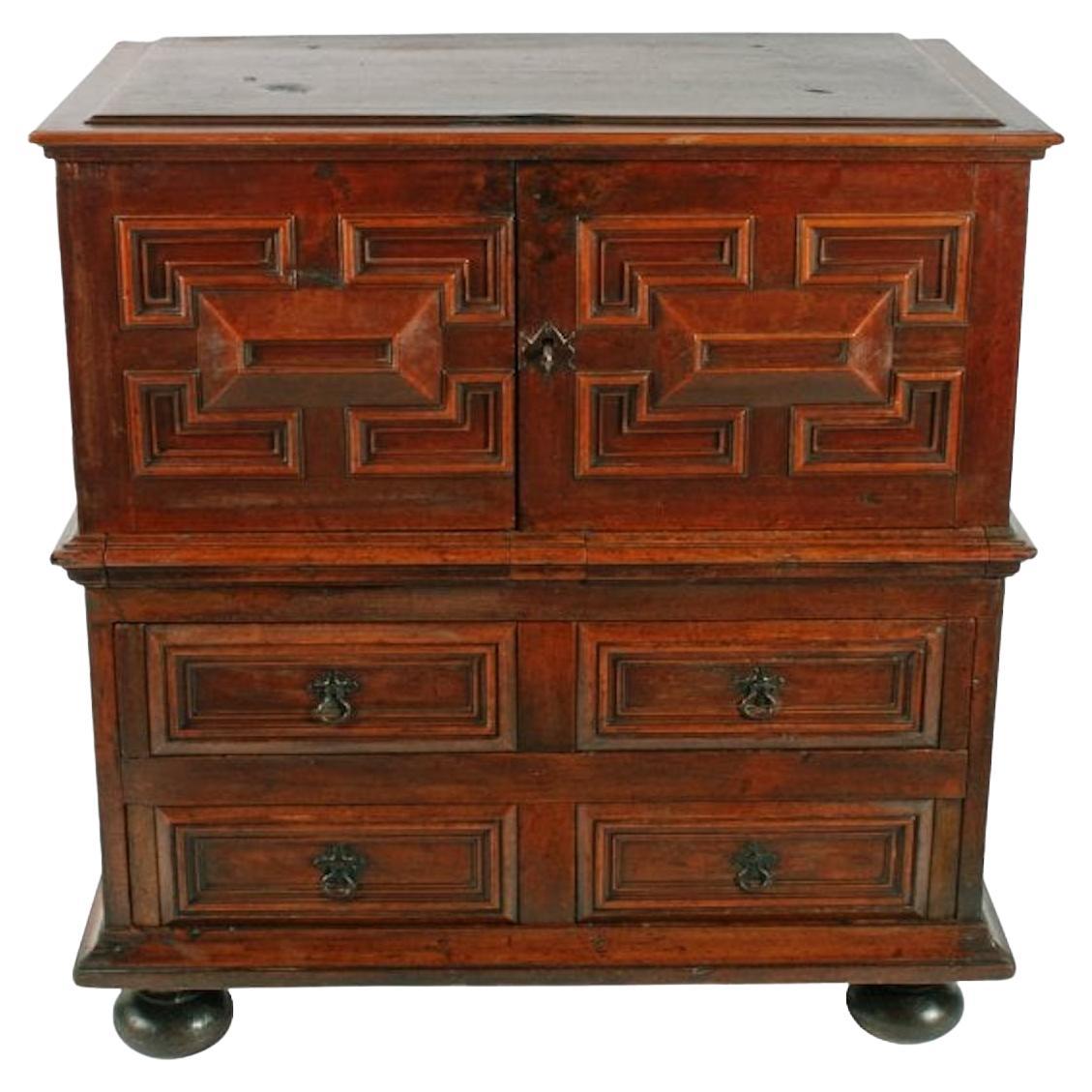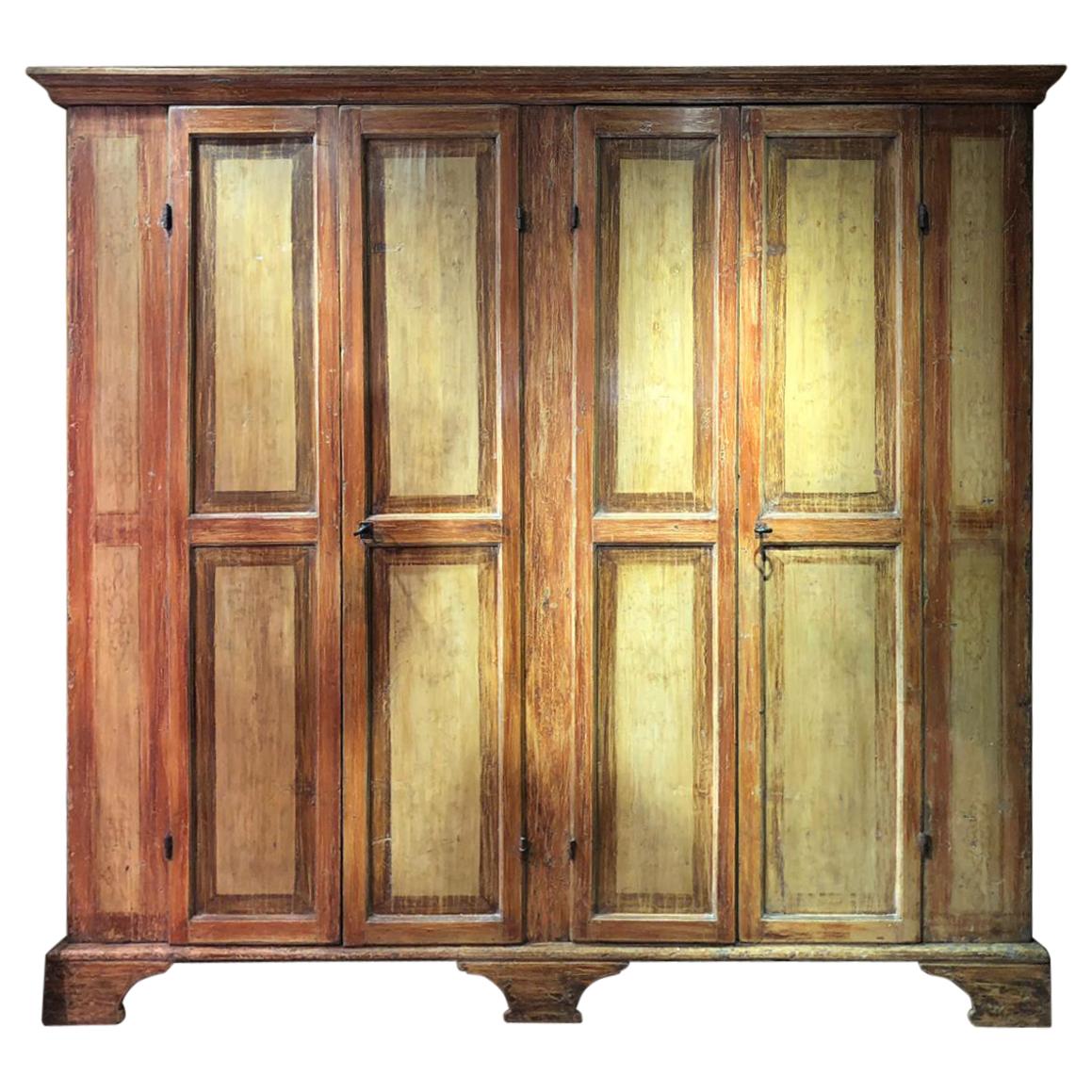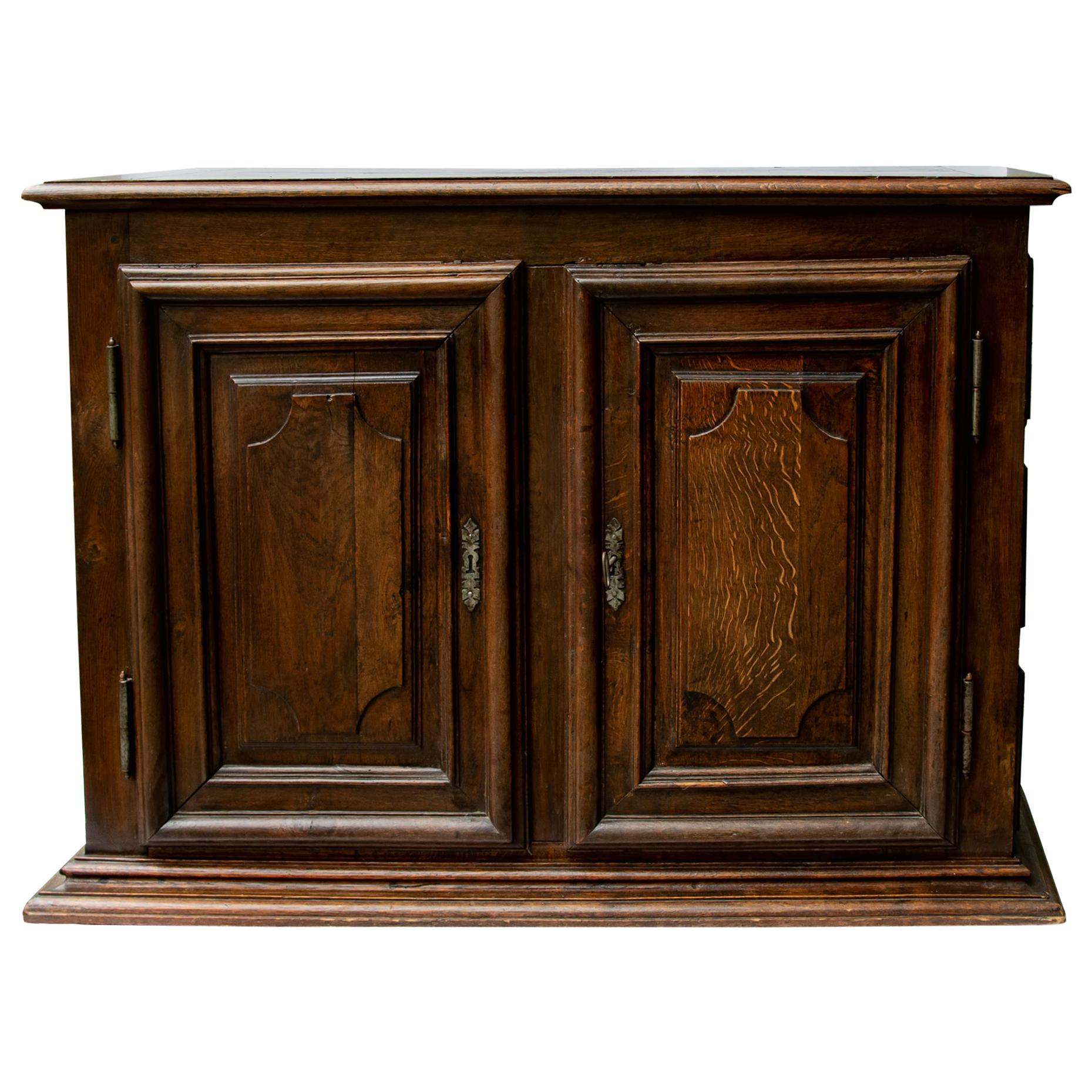Items Similar to Fine and Rare 17th Century Japanese Mulberry Wood Gilt-Lacquer Cabinet on Stand
Video Loading
Want more images or videos?
Request additional images or videos from the seller
1 of 13
Fine and Rare 17th Century Japanese Mulberry Wood Gilt-Lacquer Cabinet on Stand
About the Item
An outstanding and rare, 17th-century Japanese mulberrywood gilt-lacquer cabinet raised on a later stand.
This fine and exceptional two-door, gilt-heightened cabinet - reputedly in mountain mulberry wood - decorated in the typical Japanese manner with objects of reverence, opens to reveal a number of graduated fitted drawers, including one secret compartment. The drawer fronts beautifully decorated with gilded branches, black leaves and red flowers. The ivory crysanthemums, with additional embellishments of delicate red and black details, and the geese (along with tiny insects) to the door fronts are exquisite. The interior of the doors gilded with birds and what appear to be mulberry fruit issuing from branches executed in black and gold.
Retains its side-carrying handles and a working door lock within the elaborate escutcheon; all mounts very-admirably worked. This antique is in excellent condition, of deep rich colour and patina.
Ivory License Ref Number: TN2V26DM
Export lacquer cabinets destined for Europe were later raised on stands as the Japanese traditionally sat on the floor.
The goose in Japanese art narrative represents, inter alia, poetry and autumn. The rooster was domesticated thousands of years ago, where it was hailed for its 'benevolence, faithfulness and courage'. The chrysanthemum (depicted on the cabinet door front) is the emblem of the highly-revered Japanese Imperial family.
REFERENCES & FURTHER READING:
V&A Explore The Collections - Cabinet On Stand
Mulberry: The Material Culture of Mulberry Trees - available on Amazon, for example.
- Dimensions:Height: 66.54 in (169 cm)Width: 35.44 in (90 cm)Depth: 19.89 in (50.5 cm)
- Materials and Techniques:
- Place of Origin:
- Period:
- Date of Manufacture:circa 1650
- Condition:Repaired: Some old minor separation in the joints of the doors, as one would expect in something of this age, has been most-expertly stabilised and made flush - thus there is no movement in the structure. Wear consistent with age and use. Retains its side-carrying handles and a working door lock within the elaborate escutcheon; all mounts highly-admirably worked. This antique is in excellent condition, of deep rich colour and patina.
- Seller Location:Lymington, GB
- Reference Number:
About the Seller
5.0
Vetted Seller
These experienced sellers undergo a comprehensive evaluation by our team of in-house experts.
Established in 1957
1stDibs seller since 2018
33 sales on 1stDibs
Typical response time: 15 hours
- ShippingRetrieving quote...Ships From: Lymington, United Kingdom
- Return PolicyA return for this item may be initiated within 14 days of delivery.
More From This SellerView All
- Fine Rare Pair 17th Century Oyster Walnut Chests on StandsLocated in Lymington, GBA fine, and rare, very closely-matched pair of late-17th century oyster walnut chests on stands. English, Charles II period, ca 1685. Both with f...Category
Antique 17th Century English Charles II Commodes and Chests of Drawers
MaterialsWalnut
- 19th Century Venetian Rococo Lacquer CabinetLocated in Lymington, GBAn antique Venetian rococo japanned (or 'lacquer') cabinet. This rare and sophisticated antique cabinet separates in two, with bombé and serpentine profiles. The particularly fine ...Category
Antique Mid-18th Century Rococo Cabinets
MaterialsLacquer
- Early 18th Century Coromandel Lacquer Corner CabinetLocated in Lymington, GBAn early-18th century Coromandel lacquer corner cupboard or cabinet. This is rare - high quality Coromandel lacquer work (incised decoration) - not to be confused with the usual English japanned versions. This is also referred to as Bantam work, originating in Bantam, Dutch East Indies, and China, for export to the European market. The subject matter is of a major pavilion with numerous courtiers - most unusual to see only females - it has been suggested that they may be concubines to a Mandarin. All of high quality and in the sought-after and refined chinoiserie taste. In very good unrestored state, retaining vibrant colours and all its original hardware. This is a chic antique, and makes a lovely chinoiserie drinks cabinet...Category
Antique Early 18th Century English Cabinets
MaterialsLacquer
- Early 18th Century Japanned Double Corner CabinetLocated in Lymington, GBA rare chinoiserie standing double corner cabinet, or cupboard. English, George I period, ca 1720. Often erroneously referred to as lacquer work, this is in fact japanned. Beautifully decorated with idyllic scenes of rockwork, pagodas, people, trees, birds, water, with bridges and a boat. This is a lovely and very useful addition to a room - where corners can present furnishing dilemmas - and this is an ideal antique drinks cabinet. These have always been very hard to find, as opposed to the more usual Georgian hanging corner cupboards...Category
Antique Early 18th Century English George I Cabinets
MaterialsLacquer
- Fine George I Burr Walnut Secretaire CabinetLocated in Lymington, GBA fine English George I-period burr (burl) walnut secretaire cabinet. Early-18th century, ca 1720. The top section separates from the base and opens to reveal numerous fitted drawers, behind doors with original bevelled arched mirror plates. The base contains a fall-front fitted secretaire with small drawers, two of which have secret drawers. Engraved mounts are contemporary if not original. All locks and cross-grained mouldings are original. Beautiful colour throughout with superb matched burr veneers within herringbone lines. Bun feet are original. Lined throughout in best quality English oak. The well-patinated green, gilt-tooled liner in the writing surface appears original. Very much in the style of John Old & William Ody. One of the most original early-18th century pieces of English walnut cabinet...Category
Antique 18th Century English George I Cabinets
MaterialsWalnut
- Rare Chinese Kangxi Polychrome Coromandel Lacquer CasketLocated in Lymington, GBA rare Chinese polychrome Coromandel or ‘Bantam Ware’ lacquer casket or table cabinet, Kangxi period (1661-1722). Circa 1700. This fine small Chinese export lacquer fitted casket is decorated overall with polychrome incised decoration. Opening with two doors revealing a red interior with fitted drawers and a hinged rising top. In superb, almost entirely original condition, retaining its vivid colours and fine details with courtiers in a pavilion and on horseback amidst foliage and formal palace gardens. The small bun-type feet are historical replacements. Interestingly bearing an antique-script inventory #25 and A I on the base. Nb. Bantamwork or Coromandel lacquer, not to be confused with ‘japanning’, is the term applied to decoration that is cut into a layer of gesso and then lacquered in colours. Much of the lacquer was transhipped from China through Coromandel in India, or the Dutch colony Batavia, Java. References: Coromandel lacquer or ‘Bantamwork’, with its characteristic incised decoration, was made in Henan province in northern China from the latter part of the Ming dynasty and exported to Europe from the end of the 17th century through the East India Company’s and VOC trading posts on the Coromandel coast of India. The technique consisted in overlaying a base of wood with a series of increasingly fine white clays and fibrous grasses. Over this surface, lacquer was applied and polished before the design was incised and the hollowed out portions filled with colour and gilt and finished with a clear lacquer to protect it. Although John Stalker and George Parker used the term ‘Bantamwork’, the contemporary layman usually called it ‘cutt-work’, ‘cutt Japan’ or ‘hollow burnt Japan’. Stalker and Parker discuss two types of ‘Bantam-work’ – flat and incised – in their Treatise on Japanning and Varnishing of 1688, noting that it ‘was done in colorus mix’t with a gum water’. They also considered that it was ‘almost obsolete, and out of fashion, out of use and neglected….’ although admitted that ‘it was very pretty, and some are more fond of it, and prefer it to the other…’. This casket/ table cabinet now on offer is related to one formerly with Malletts and illustrated in A. Bowett, 'English Furniture 1660-1714: From Charles II to Queen Anne', Woodbridge, 2002, p. 150, plates 5:9. A much larger closely-related Bantam work coffer with rising lid was offered in the ‘Asian Art in Cologne’ sale lot 114 on 11th December 2021. Estimated @ £60,000 – £79,000. Mme de Pompadour, mistress to King Louis XV from 1745 to 1751, was an avid collector and admirer of Chinese Coromandel or Bantam work and was probably largely responsible for the very high prices recorded for such pieces, sometimes 10 times or more the price of ordinary furniture of equivalent quality. A Coromandel cabinet...Category
Antique 18th Century Chinese Cabinets
MaterialsLacquer
You May Also Like
- Late-17th Century, Dutch Oak Cabinet on StandLocated in London, GBDutch oak cabinet on stand An exceptional late 17th-century Dutch oak cabinet-on-stand with an ornately carved interior, depicted in the Baroque man...Category
Antique Late 17th Century Dutch Baroque Cabinets
MaterialsMetal
- Rare 17th Century Neapolitan Ebony Tortoiseshell and Mother of Pearl CabinetLocated in Benington, HertsRare 17th Century Neapolitan Ebony Tortoiseshell and Mother of Pearl Cabinet From the Perego Collection in Monza, an important 17th Century Italian arch...Category
Antique 17th Century Italian Cabinets
MaterialsTortoise Shell, Mother-of-Pearl, Ebony
- Extremely Fine and Rare 17th-Century Japanese Export Lacquer and Inlaid CabinetLocated in Amsterdam, NLAn extremely fine and important Japanese lacquer cabinet with gilt-copper mounts for the European market Edo period, late 17th century The pictorial style decorated rectangular...Category
Antique Late 17th Century Japanese Lacquer
MaterialsBrass
- Charles II Cedar Wood Chest, 17th CenturyLocated in Southall, GBCharles II Cedar Wood chest A 17th century Charles II cedar wood cushion fronted chest. The chest is smaller than usual and comes in two parts, the two door cupboard top has be...Category
Antique 17th Century English Cupboards
MaterialsCedar
- 17th Century Italian Four Doors Lacquered Big Shelves CupboardsLocated in IT17th century Italian lacquered big cabinet four doors, arranged internally with shelves original lacquer originali hardwares (lockers, hinges and keys) ...Category
Antique Late 17th Century Italian Romantic Cabinets
MaterialsWood
- 17th Century English Oak CupboardLocated in Mt Kisco, NY17th century English oak cupboard. The cupboard has a dark stained oak patina with a raised panel design on each side. The cupboard doors ...Category
Antique Late 17th Century Welsh Charles II Cupboards
MaterialsOak
Recently Viewed
View AllMore Ways To Browse
Wood Rare Antique Furniture
Numbered Pieces
Gold Numbered Pieces
Used Fitted Kitchens
Used Fitted Kitchen
Antique Black Wood Cabinet
Antique Cabinet Stand
Antique Carrying Case
Antique Gilt Cabinet
Island Case
Black Cabinet With Wood Interior
Traditional Wood Storage Cabinet
Mounted Rare Wood
17th Century Gilt
Wood Gilt Europe
Flower Stand Wood
Elaborate Antique Cabinet
Antique Japanese Cabinets





